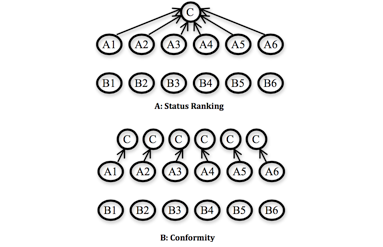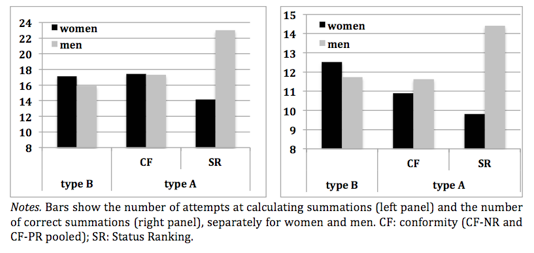Does competitive ranking on the job induce lower effort on the part of women? In their BSE Working Paper (No. 817) “Status Anxiety Makes Women Underperform,” Arthur Schram, Jordi Brandts, and Klarita Gërxhani demonstrate in a controlled lab experiment that priming participants prior to exerting effort that their results will be ranked and asking them to publicize that rank afterwards causes women to underinvest in effort, but stimulates men to exert more.
Competition in the workplace
Competition is more than a rivalry for resources in the workplace. When we compete we are generating a ranking of relative performance with our peers. In competitive work environments, and principally those in which evaluations of performance become public, the status anxiety that social ranking may induce can differentially impact the performance of men and women. The gender gap that exists in highly competitive environments may be perpetuated by this effect. So understanding the role that anticipated status ranking might have on women is important in understanding why women are underrepresented in competitive labor environments. The possible anxiety generated by anticipating that a comparison may occur could thus play a significant role in the way women sort themselves in labor markets, contributing to gender inequality together with other factors.
Previous studies have focused on the effect of resource rivalry and have shown that competition for resources can negatively affect women’s performance for some tasks and that women tend to shy away for competitive environments. The authors of “Status Anxiety Makes Women Underperform” abstract from the resource rivalry aspect of competition and uniquely study what happens when people are told prior to engaging in a task that they will be evaluated and ranked, and will then have to report their performance to others.
The experiment
To study the impact of status ranking the authors devise a clever experiment composed of different groups of randomly selected (university student) participants. The task: select the highest number from two matrices and sum them together and do this as many times as possible in 15 minutes. The payment scheme involves no rivalry, since each person is paid based on the number of his or her correct responses. The members of the first group, the B-group, perform the task individually and will have no performance ranking disclosed and are not asked to disclose this to others. This is their control group. Those they call C-group are participants whose sole role is to have scores reported to them by the treated group.
Those who report their scores and rankings, the treated group A-group participants, are composed of two treatment groups: both A-groups are primed with a text that they will have to present their score to a C-group participant in a different room. Presenting their score, but not their relative ranking (if they know it), to individual C-group participants yields the “Conformity” treatment – that is, each A-group participant in this treated group is individually paired to a C-group participant. The second A-group is treated by a “Social Ranking” disclosure, wherein all participants present both their score and their relative rank to one C-group participant. The Conformity treatment is to control for the possibility that simply having to report to someone can induce lower performance. The design of the experiment is displayed in the figured below.

Those A-group participants who were in the Conformity treatment were further stratified into a group that would eventually be told their ranking and those who were never disclosed their ranking. This was done in the event that this knowledge may affect their performance. In both cases this group never disclosed the ranking to the C-group participant. The authors do not find any difference within or between genders on this treatment dimension and pool all respondents together.
How does anticipating social ranking affect effort and performance?
Their results, as shown in the figure below, demonstrate the effect of anticipating the social ranking. The control, B-group taking the test displays no differences in either attempts (the left panel) or correct answers (right panel) between the two genders. The same result occurs for those in the Conformity (CF) treatment group.

However, significant differences arise in the A-group that is treated by anticipating having to report their Social Ranking (SR) to the C-group member. Here, women reduce their effort (by making lower attempts) and consequently have significantly lower correct answers – although the fraction of their correct answers to their attempts is about the same as in the control group, indicating that the investment in effort is what is most impacted. Men, however, significantly increase their effort via more attempts, but this increase in effort is not met with significant increases in correct answers – where their accuracy as reflected by their fraction of correct answers-to-attempts falls slightly but isn’t significantly different from the men in the control B-group, and in absolute levels is actually smaller than that of women. But the authors note that this “accuracy” fraction between men and women in the SR and control group is actually not statistically different, further indicating that the SR treatment is working on the amount of effort invested.
Taken together their results reveal that when individuals anticipate that their performance will be evaluated along a competitive dimension, and more importantly that it will be publicly disclosed to another, it works to induce different levels of effort between the genders. Women underinvest in effort, whereas men increase theirs. Status may play a more important role for men than it does for women and the anticipated status anxiety could have negative results for perceived female effort and participation in these types of incentive schemes.
Can we have women opt in instead of opt out?
Social status anxiety may be playing an important role in the gender differences that we see in the labor market participation of women. Indeed the power of the authors’ results is that this mixed gender environment did not involve a rivalry for resources (say, that one’s performance is contingent not only on your performance but on others’ ability to remove your reward via their performance). They further note that total productivity in their experiment (the total correct answers) was on average the same in both the control and the treated groups, indicating that economic efficiency is not impacted by the gender inequality that results under status anxiety. However, given that conditional on their chosen effort level women’s accuracy was not impacted, the results suggest efficiency and equity could be improved if one could design a system that diminished or eliminated the status anxiety induced in women while maintaining the stimulating effect that status ranking seems to have on men.
These results don’t elaborate whether women are choking under pressure or become demotivated by a peer-ranking system. Other researchers have proposed methods to bring about greater equity. For example, basing performance on individual versus relative performance may have more women opt in. Further research should then test that new incentive mechanisms, which may equalize equity, do not impact economic efficiency. It seems though that we still have a lot more room to grow on gender equality.



